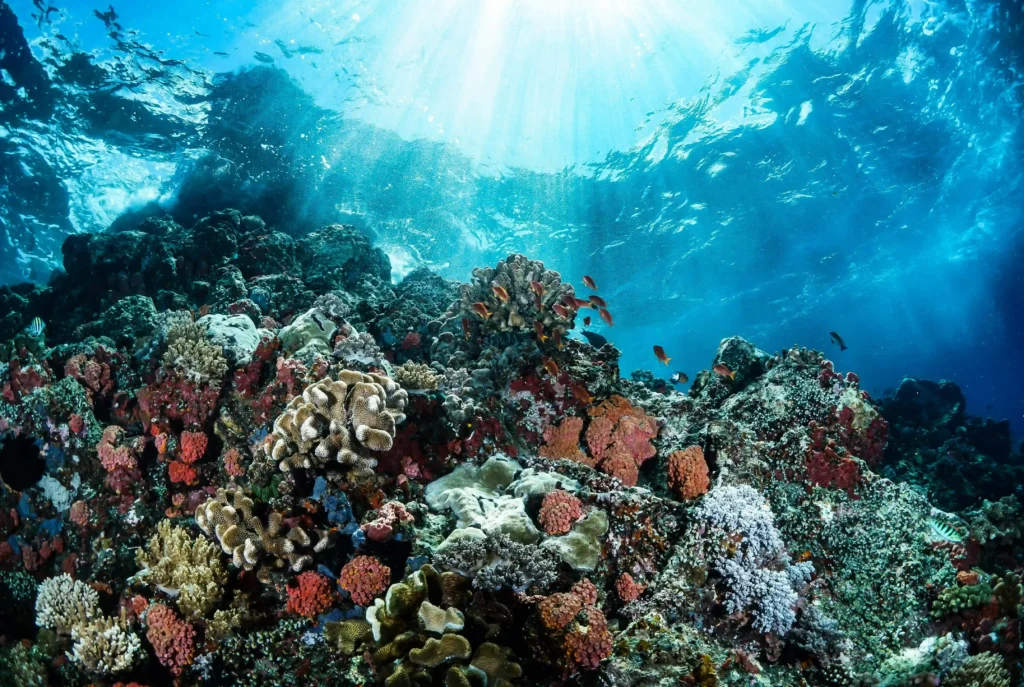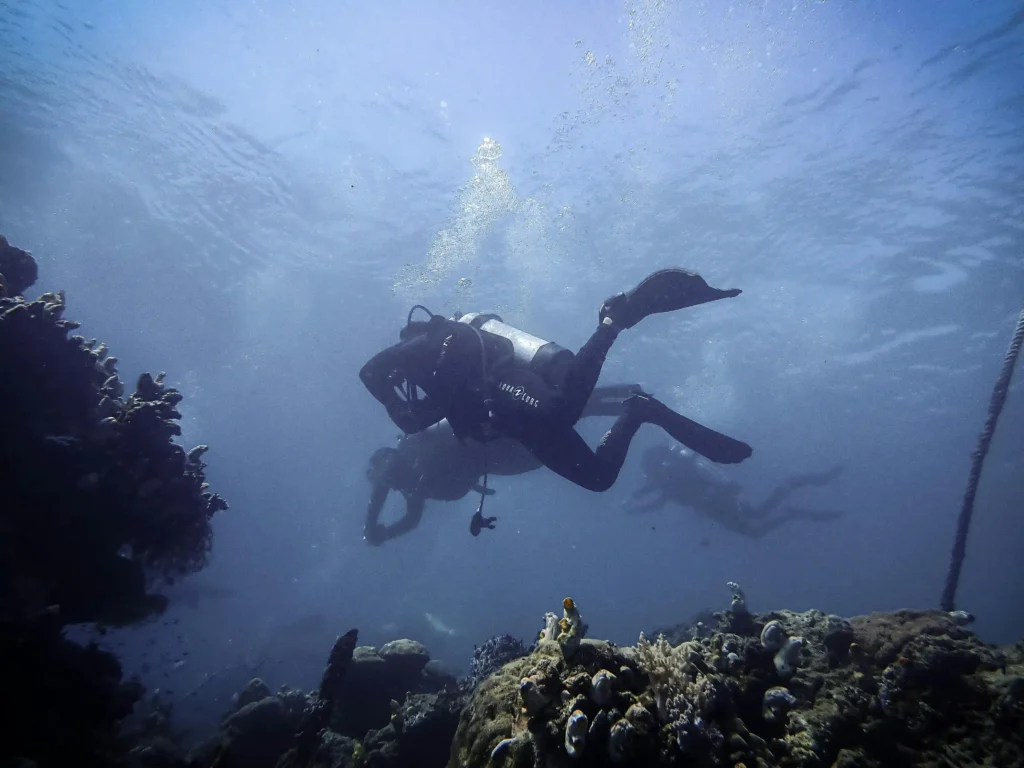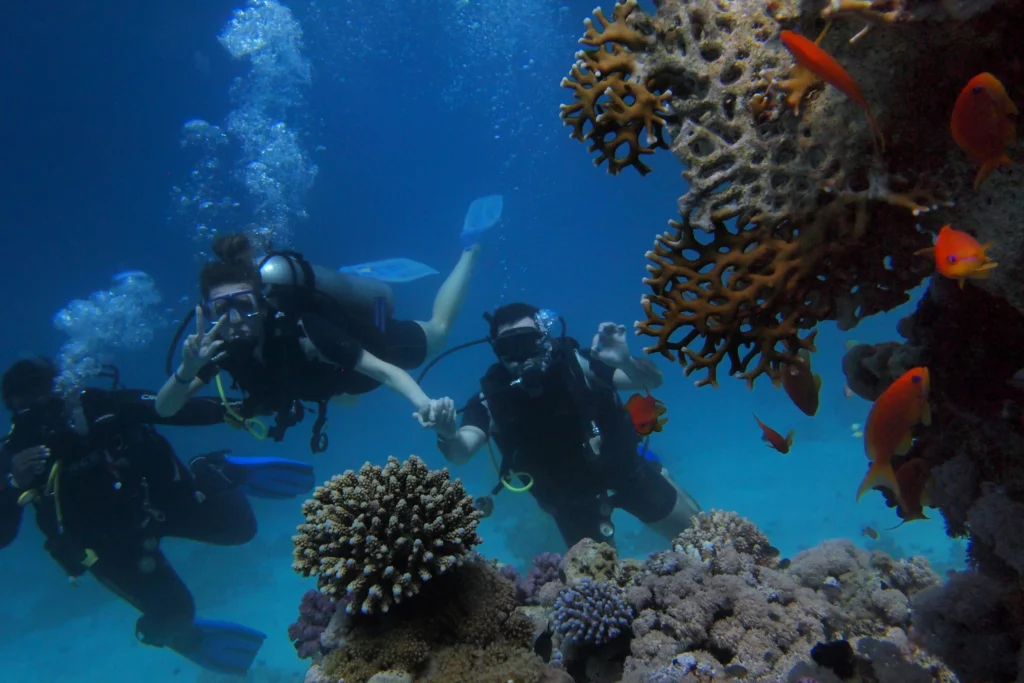Sulawesi is a diver’s dream. One moment you might be searching for tiny, rare critters in black volcanic sand, and the next you could be drifting along coral walls alive with turtles, sharks, and schools of fish. Whether your passion is muck diving, coral reefs, or big encounters in open water, Sulawesi offers something for every kind of diver, and we will help you find it.
In this guide, you will discover the best places to dive in Sulawesi, the marine life you can expect to see, and the best times to plan your trip.
Why Dive in Sulawesi?

When it comes to diving in Indonesia, most people immediately think of Bali or Raja Ampat. But if you’re looking for an off-the-beaten-path adventure, head to Sulawesi.
Set within the Coral Triangle, the global center of marine biodiversity, these waters are home to hundreds of coral species and thousands of fish. Here you can enjoy several different types of diving in one trip, from exploring reefs alive with color to searching for rare critters hidden in the sand.
Sulawesi’s volcanic geography adds even more variety. Black sand slopes are perfect hunting grounds for macro life, calm sheltered bays provide safe havens for smaller species, and steep drop-offs attract schools of pelagics. With so many habitats packed into one region, each dive reveals a new side of the island’s underwater world.
4 Best Dive Destinations in Sulawesi

Wondering where to dive first? Sulawesi has a little bit of everything, from tiny critters to colorful reefs and encounters with bigger marine life. Each destination has its own flavor, so the more you see, the more sides of Sulawesi you will get to know.
Here are some of the places that should be on every diver’s list:
1. Lembeh Strait: Muck Diving Capital
Lembeh Strait is world-renowned for its muck diving, offering a chance to see some of the ocean’s most unusual critters. Its black volcanic sand is the backdrop for frogfish, flamboyant cuttlefish, mimic octopuses, and nudibranchs found almost nowhere else. Every dive feels like a one-of-a-kind treasure hunt for macro lovers and photographers.
Continue reading: World Class Diving in Lembeh Strait
2. Bunaken National Park: Walls and Turtles
Bunaken is famous for its soaring coral walls that drop dramatically into the blue. With more than 390 coral species, the reefs are bursting with life, from green turtles and reef sharks to vast schools of tropical fish. The combination of scale, color, and easy encounters makes it one of Sulawesi’s most iconic dive sites.
3. Wakatobi: Remote and Pristine Reefs
Wakatobi offers some of the healthiest and most colorful reefs in all of Indonesia. Its remote location keeps the marine environment vibrant and teeming with fish, from shallow coral gardens to sweeping walls. Diving here feels like stepping into a pristine underwater paradise.
4. Togian Islands: Drift Dives and Hidden Wrecks
The Togian Islands are Sulawesi’s hidden gem, perfect for divers seeking both adventure and tranquility. You can explore lush coral reefs, ride exhilarating drift dives, and even discover World War II wrecks beneath the surface. With fewer visitors, the Togians deliver a rare sense of diving in your own private ocean.
What Kind of Diving Does Sulawesi Offer?

Diving in Sulawesi comes in many forms, each showing a different side of the island’s waters. You might spend one dive exploring volcanic sand to find tiny critters, then the next drifting past coral walls where turtles and reef sharks roam.
The main diving experiences you’ll find in Sulawesi include:
- Muck diving: This type of diving focuses on exploring sandy or silty slopes where unusual marine life hides in plain sight.
- Drift diving: We refer to this type of diving in areas where ocean currents naturally transport you along the reef. Instead of constant finning, you simply go with the flow, watching the scenery unfold as you glide past.
- Scuba diving: The most common way to explore Sulawesi’s underwater world, letting you glide weightlessly over reefs, along slopes, and through habitats filled with marine life both big and small.
- Night diving: This is when divers explore the reef after dark, using torches to reveal creatures that stay hidden during the day. The ocean comes alive with stargazers, bobbit worms, and nocturnal cephalopods on the hunt.
You might also like: Types of Diving: Explore the Most Popular Dive Styles
Marine Life You Might See in Sulawesi
At the heart of the Coral Triangle, the global center of marine biodiversity, Sulawesi’s waters support an extraordinary variety of species. More than 500 types of coral and thousands of reef fish thrive here, alongside tiny critters, colorful reef dwellers, and more.
You can expect to encounter:
- Macro life: On black sand slopes and rubble sites, you’ll find frogfish, ghost pipefish, flamboyant cuttlefish, and other rare critters that make Sulawesi especially famous among muck divers.
- Reef fish and invertebrates: Along coral gardens and reefs, expect to see clownfish, butterflyfish, parrotfish, wrasse, moray eels, and colorful invertebrates such as mantis shrimp and harlequin shrimp, a highlight of scuba diving.
- Pelagic species: In areas with stronger currents, divers drift past turtles, reef sharks, barracuda schools, trevallies, and sometimes even dolphins or whale sharks.
- Nocturnal marine life: During night dives, the reef transforms with stargazers, bobbit worms, nocturnal cephalopods, and mandarin fish performing their dusk mating rituals.
And this is only the beginning. Lembeh in particular is renowned for an even wider range of rare and unusual critters, with new species still being recorded.
When Should You Go to Sulawesi?
Diving is possible year-round, but the best season is from July to October, when the seas are calmest, visibility is clearest, and water temperatures hover around 25–26 °C (77–79 °F). These conditions are ideal for underwater photography and bring critters closer to the shallows, making muck dives even more rewarding. It is also the time when drift dives are smoother and night dives are especially comfortable for spotting Sulawesi’s nocturnal life.
Ready to Dive in Sulawesi?

Now that you know what makes diving in Sulawesi so special, are you ready to see it for yourself? The island offers an incredible mix of experiences, from rare critters hiding in the sand to pelagics in open water and the unique sights of a night dive. Lembeh is at the heart of it all, with some of the best opportunities to experience this variety up close.
That’s exactly what we bring to life at Solitude Lembeh Resort. From the moment you arrive, we make your dives smooth and stress-free. Our PADI-certified guides know where to find Lembeh’s rarest critters and will help you spot them up close. And when the day is done, you can retreat to your villa in the gardens, unwind, and enjoy a warm, home-cooked meal prepared just for you.
Book your stay with Solitude and let us show you the underwater world that makes Sulawesi truly unforgettable!